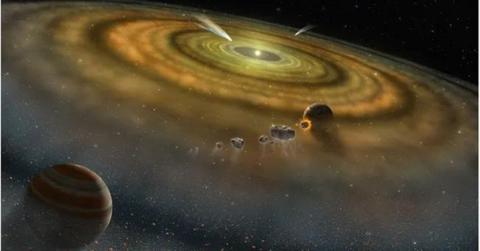Chaotic Collision with Earth May Have Led to Formation of Our Planet's Moon

Could Jupiter have played a part in the formation of Earth's moon?
It seems that a significant cosmic event, dubbed the "great instability," caused upheaval among the planets, resulting in gas giants hurtling through space before settling into their current orbits.
This event likely occurred between 60 and 100 million years after the solar system's formation, according to scientific analysis linking a specific type of meteorite to an asteroid once influenced by these wandering planets.
Moreover, researchers suggest that this planetary migration, particularly by Jupiter, may have contributed to the formation of Earth's moon by disturbing the orbit of a protoplanet called Theia. This disturbance could have led to a collision with Earth, ejecting debris into space that eventually coalesced to form the moon, Live Science reported.
Through studying the compositions and locations of various celestial bodies like asteroids and comets, scientists have gained insights into this early chaos in the solar system's history. However, some puzzles remain regarding the precise sequence of events.
For instance, certain objects in the solar system, such as asteroids and comets, contain materials inconsistent with their expected origins in the solar nebula. Instead, it's plausible that these objects formed closer to the sun before being scattered outward, possibly by the migrating gas giants.
Initially, the gas giant planets — Jupiter, Saturn, Uranus, and Neptune — were positioned closer together in the early solar system. Over time, gravitational interactions with distant planetesimals caused Saturn, Uranus and Neptune to migrate outward, while Jupiter moved inward. This inward migration likely destabilized bodies in the inner solar system.
- What Lies Beneath: NASA Scientist Believes Aliens May Have Found 'Perfect' Hiding Spot in Earth's Oceans
- Global Threat: Russia Insider Warns West of 'World War Using Nuclear Weapons' Amid Escalating Support for Ukraine
- Countdown to Disaster? Ex-NATO Official Warns Russia, Iran and China Could Wage WWIII in Just Years
This theory of orbital instability, known as the Nice Model, suggests that this chaotic period occurred less than 100 million years after the solar system's formation. However, debates persist regarding the exact timing of this instability, with some proposing an earlier occurrence within four million years and others suggesting a later timeframe around 60 million years.
To address these uncertainties, planetary scientist Chrysa Avdellidou and her team focused on EL enstatite chondrites, meteorites similar in composition to Earth's material. These meteorites are linked to the Athor family of asteroids, which reside in the asteroid belt between Mars and Jupiter. By studying these meteorites, the team aimed to pinpoint when the great instability occurred.
Never miss a story — sign up for the Front Page Detectives newsletter. Be on the scene the moment news breaks.
Their findings, published in the journal Science and presented at the European Geological Union General Assembly, suggest that Jupiter's migration could have scattered the progenitor of the Athor family into the asteroid belt approximately 60 million years after the solar system's formation. This timeframe aligns with data on Jupiter's Trojan asteroids, providing a clearer picture of the great instability.
This period coincides with the collision between Earth and Theia, believed to have formed the moon. While it's challenging to definitively prove these events from billions of years ago, the evidence strongly suggests a connection between Jupiter's migration, asteroid scattering and moon formation.
Become a Front Page Detective
Sign up to receive breaking
Front Page Detectives
news and exclusive investigations.
